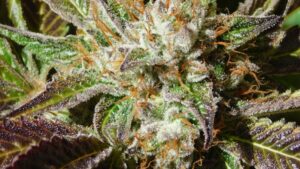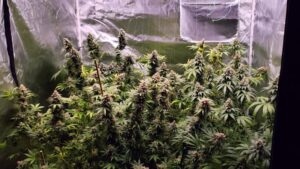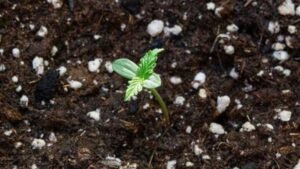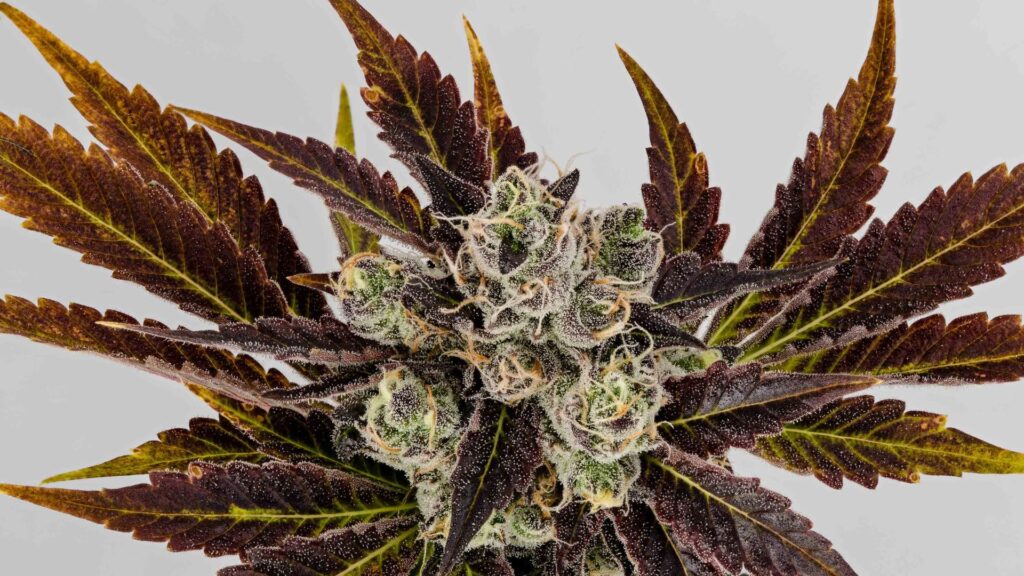The world of cannabis cultivation is vast and diverse, with countless strains offering unique flavors, aromas, and effects. Among these, the Apples and Bananas strain stands out as a delightful and intriguing option for both recreational and medicinal users. This hybrid strain, known for its captivating blend of fruity flavors and potent effects, has garnered attention and acclaim within the cannabis community.
Developed through careful breeding and selection, the Apples and Bananas strain combines the best traits of its parent cultivars to create an experience that is satisfying to the palate and the mind. Rooted in the rich genetics of various cannabis strains, Apples and Bananas offer a distinct profile that sets them apart from other varieties.
In this guide, we will delve into the world of Apples and Bananas cannabis cultivation, exploring its origins, characteristics, and optimal growing techniques. Whether you’re a novice grower or a seasoned enthusiast, join us as we uncover the secrets to successfully cultivating this exceptional strain and enjoying its bountiful harvest.
Brief Overview of the Apples and Bananas Cannabis Strain:
The Apples and Bananas cannabis strain is a hybrid cultivar renowned for its irresistible combination of fruity flavors and potent effects. This strain is the result of meticulous breeding efforts, combining the genetics of various cannabis varieties to produce a unique and memorable experience for users. With hints of both apples and bananas weed strain and bananas in its aroma and taste, this strain offers a refreshing departure from the typical cannabis flavor profiles.
Importance of Proper Cultivation Techniques for Optimal Growth:
Successful cultivation of the Apples and Bananas strain relies heavily on employing proper techniques throughout the plant’s life cycle. From germination to harvest, ensuring the right environmental conditions, nutrient balance, and care practices is crucial for maximizing yield, potency, and overall quality. By understanding and implementing these techniques, growers can unlock the full potential of this exceptional strain and achieve optimal results.
Purpose of the Blog Post: Providing a Comprehensive Guide to Growing This Strain:
The primary objective of this blog post is to offer growers a comprehensive guide to cultivating the Apples and Bananas cannabis strain. By providing detailed insights, tips, and instructions, we aim to empower both novice and experienced growers to navigate the cultivation process with confidence and success. Whether you’re a hobbyist cultivator or a commercial producer, this guide serves as a valuable resource for unlocking the secrets to growing top-quality Apples and Bananas cannabis.

What is an apple and banana strain of cannabis?
The Apple and Banana strain of cannabis, also known simply as Apples and Bananas, is a hybrid cultivar cherished for its distinctive fruity aroma, flavor, apples and bananas weed strain and potent effects. This strain is the result of careful breeding and Exotic Flower selection, blending the genetics of various cannabis varieties to create a unique and memorable experience for users.
Appearance: The buds of the Apple and Banana strain typically exhibit vibrant hues of green with hints of yellow and orange, reminiscent of ripe fruits. They are often adorned with a generous coating of trichomes, giving them a glistening appearance.
Aroma and Flavor: True to its name, the Apple and Banana strain delights the senses with a compelling blend of fruity aromas and flavors. Notes of apples bananas strain and tropical banana dominate the palate, accompanied by subtle undertones of earthiness and spice. This harmonious fusion of flavors sets this strain apart, making it a favorite among those seeking a refreshing and enjoyable cannabis experience.
Effects: The effects of the Apple and Banana strain are typically balanced, offering a blend of uplifting euphoria and relaxing body sensations. Users often report a sense of creativity and focus, coupled with a gentle, soothing relaxation that eases both the mind and body. These effects make the Apple and Banana strain suitable for various occasions, whether seeking inspiration during creative endeavors or unwinding after a long day.
Medicinal Benefits: Beyond its recreational appeal, the Apple and Banana strain also boasts potential medicinal benefits. Thanks to its mood-enhancing properties, some users find relief from symptoms of stress, anxiety, and depression. Additionally, its calming effects may help alleviate mild pain and muscle tension, offering therapeutic relief for those in need.
In conclusion, the Apple and Banana strain of cannabis represents a delightful convergence of flavor, aroma, and effects, making it a sought-after choice among cannabis enthusiasts. Whether enjoyed for its recreational appeal or medicinal benefits, this hybrid cultivar continues to captivate users with its fruity allure and satisfying experience.

Setting Up Your Grow Space
Indoor vs. Outdoor Cultivation Considerations
When considering cultivation options for the Apple and Banana strain of cannabis, growers must weigh the pros and cons of indoor versus outdoor cultivation.
Indoor Cultivation:
- Provides greater control over environmental variables such as temperature, humidity, and lighting.
- Allows for year-round cultivation regardless of external climate conditions.
- Requires investment in equipment such as grow lights, ventilation systems, and climate control devices.
- Suitable for growers with limited outdoor space or those seeking maximum control over the growing environment.
Outdoor Cultivation:
- Utilizes natural sunlight, reducing energy costs associated with artificial lighting.
- Allows plants to grow to larger sizes, potentially resulting in higher yields.
- It relies on seasonal changes and climate conditions, limiting cultivation to specific times of the year.
- It may be subject to environmental factors such as pests, diseases, and inclement weather.
Ideal Climate and Environmental Conditions
To thrive, the Apple and Banana strain of cannabis requires specific climate and environmental conditions conducive to healthy growth and development.
Temperature:
- Thrives in temperatures between 70-85°F (21-29°C) during the vegetative stage.
- Prefers slightly cooler temperatures of 65-80°F (18-27°C) during the flowering stage to prevent heat stress and promote resin production.
Humidity:
- Maintains relative humidity levels of 40-60% during the vegetative stage to prevent mold and mildew.
- Lowers humidity to 30-40% during the flowering stage to reduce the risk of bud rot and improve resin production.
Lighting:
- Requires adequate light exposure, whether from natural sunlight (outdoor cultivation) or artificial grow lights (indoor cultivation).
- During the vegetative stage, provide 18-24 hours of light per day, transitioning to a 12/12 light/dark cycle during the flowering stage to induce flowering.
Equipment and Supplies Needed for Successful Cultivation
To cultivate the Apple and Banana strains successfully, growers must invest in the necessary equipment and supplies to create an optimal growing environment.
Basic Equipment:
- Grow tents or dedicated grow space (indoor cultivation)
- Containers or pots for planting
- High-quality soil or growing medium
- pH testing kit for monitoring soil acidity
- Watering cans or irrigation systems
Climate Control:
- Grow lights (LED, HID, or fluorescent) for indoor cultivation
- Ventilation system (fans, exhaust fans, carbon filters) to regulate airflow and remove excess heat and humidity
- Humidifier or dehumidifier to adjust humidity levels as needed
Nutrients and Supplements:
- Balanced fertilizer formulated for cannabis cultivation
- Organic supplements (compost, worm castings) to improve soil quality and nutrient uptake
- pH-adjusting solutions to maintain optimal pH levels in soil or nutrient solution
By carefully considering indoor vs. outdoor cultivation, optimizing climate and environmental conditions, and investing in the right equipment and supplies, growers can set the stage for successful cultivation of the Apple and Banana strain, ultimately yielding a bountiful harvest of flavorful and potent buds.

Germination and Seedling Stage
A. Selecting High-Quality Seeds
Selecting high-quality seeds is paramount to the successful cultivation of the Apple and Banana strains. Here are some tips for choosing the best seeds:
- Source: Purchase seeds from reputable breeders or seed banks known for their quality, genetics and reliability.
- Appearance: Look for seeds that are dark in color and have a hard, intact shell. Avoid seeds that are light-colored, cracked, or damaged.
- Genetics: Research the genetics of the strain and choose seeds from a reputable breeder who has stabilized the genetics and maintained consistency in traits such as flavor, aroma, and potency.
- Reviews: Check reviews and feedback from other growers to gauge the reputation and reliability of the seed supplier.
B. Germination Methods and Techniques
Proper germination is the crucial first step in cultivating healthy Apple and Banana cannabis plants. Consider the following methods and techniques:
- Soaking: Place seeds in a glass of room-temperature water for 12-24 hours to soften the seed coat and encourage germination.
- Paper Towel Method: Place seeds between moist paper towels or cotton pads and keep them in a warm, dark place. Check regularly for signs of germination, usually within 24-72 hours.
- Direct Planting: Plant seeds directly into pre-moistened soil or growing medium, burying them about 1/4 to 1/2 inch deep. Keep soil consistently moist but not waterlogged.
C. Care Tips for Healthy Seedlings
Once germinated, seedlings require proper care to ensure healthy growth and development. Here are some care tips:
- Light: Provide seedlings with adequate light, whether from natural sunlight or artificial grow lights. Aim for 18-24 hours of light per day during the vegetative stage to promote vigorous growth.
- Temperature and Humidity: Maintain a temperature range of 70-80°F (21-27°C) and relative humidity of 50-70% to create an optimal growing environment for seedlings.
- Watering: Water seedlings gently and evenly, avoiding overwatering or allowing the soil to dry out completely. Use a spray bottle or watering can with a fine nozzle to prevent damage to delicate seedlings.
- Nutrients: Start with a light feeding regimen using a balanced fertilizer designed for seedlings. Gradually increase nutrient levels as seedlings mature, being careful not to overfeed and cause a nutrient burn.
- Transplanting: Once seedlings have developed a strong root system and several sets of true leaves, transplant them into larger containers with well-draining soil or growing medium.
By selecting high-quality seeds, employing effective germination methods, and providing proper care for seedlings, growers can lay a solid foundation for successful cultivation of the Apple and Banana strain, ultimately leading to healthy plants and a bountiful harvest of flavorful buds.
Flowering Stage
Transitioning from Vegetative to the Flowering Stage
Transitioning from the vegetative to the flowering stage is a critical phase in the growth cycle of the Apple and Banana cannabis strain. Follow these steps for a smooth transition:
- Adjusting Light Cycle: Gradually reduce the light cycle from 18-24 hours of light per day to a 12/12 light/dark cycle. This signals to the plant that it’s time to start flowering.
- Nutrient Adjustment: Switch to a bloom-specific fertilizer with higher phosphorus and potassium levels to support flower development.
- Pruning and Training: Consider pruning and training techniques such as topping or low-stress training (LST) to promote even canopy development and maximize light penetration to flowering sites.
B. Managing Light Cycles for Optimal Flower Development
Proper light management during the flowering stage is crucial for maximizing flower development and yield. Follow these guidelines:
- Light Schedule: Maintain a consistent 12 hours of uninterrupted darkness during the flowering stage to stimulate flower production.
- Light Intensity: Ensure sufficient light intensity during the flowering stage, whether from natural sunlight or artificial grow lights. Aim for 600-1000 µmol/m²/s of light intensity at canopy level.
- Light Spectrum: Use light sources with a spectrum rich in red and far-red wavelengths, as these are essential for promoting flowering and bud development.
C. Monitoring and Adjusting Environmental Factors
Monitoring and adjusting environmental factors is essential for maintaining optimal growing conditions and maximizing flower quality and yield. Here’s what to keep an eye on:
- Temperature and Humidity: Monitor temperature and humidity levels regularly, aiming for a temperature range of 65-80°F (18-27°C) and relative humidity of 40-50% during the flowering stage.
- Air Circulation: Ensure adequate air circulation within the growing space to prevent stagnant air and humidity buildup, which can lead to mold and mildew.
- CO2 Levels: Consider supplementing with CO2 during the flowering stage to enhance plant growth and flower production, especially in enclosed indoor environments.
- Nutrient Levels: Monitor nutrient levels in the soil or growing medium and adjust feeding schedules as needed to prevent nutrient deficiencies or excesses.
- Pest and Disease Control: Regularly inspect plants for signs of pests, diseases, or nutrient deficiencies and take appropriate measures to address any issues promptly.
By effectively managing the transition from vegetative to flowering stage, optimizing light cycles, and closely monitoring and adjusting environmental factors, growers can ensure healthy flower development and maximize the yield and quality of their Apple and Banana cannabis crop.
Apples and Bananas Strain Flowering Time
Like many cannabis varieties, the flowering time of the Apples and Bananas strain can vary depending on factors such as genetics, growing conditions, and cultivation techniques. However, apple and bananas strain on average, the flowering time for the Apples and Bananas strain typically ranges from 8 to 10 weeks.
During the flowering stage, which begins once the light cycle is adjusted to a 12/12 schedule, the Apples and Bananas plants undergo significant development as they produce dense, resinous buds with a delightful aroma reminiscent of ripe fruits. Growers can expect to see the formation apples and bananas strain seeds of colorful and fragrant flowers, with hues ranging from deep green to shades of purple, accented by vibrant orange pistils.
It’s important for growers to closely monitor the progress of their Apples and Bananas plants during the flowering stage, paying attention to factors such as nutrient levels, humidity, and temperature to ensure optimal conditions for flower development. Additionally, regular inspection for pests, diseases, and nutrient deficiencies is crucial to address any issues promptly and maintain the health and vigor of the plants.
As the flowering stage progresses, growers can observe the maturation of the buds, which will become increasingly resinous and potent. Towards the end of the flowering period, trichome development peaks, indicating that the buds are approaching their harvest-ready state. Experienced growers may choose to harvest their Apples and Bananas plants at different times within the 8 to 10-week window to achieve varying effects, flavors, and levels of potency.
In conclusion, the flowering time of the Apples and Bananas strain typically spans 8 to 10 weeks, during which growers can expect to witness the transformation of their plants into mature, resinous, and aromatic specimens ready for harvest. By providing optimal growing conditions and attentive care throughout the flowering stage, growers can maximize the yield, quality, and overall enjoyment of their Apples and Bananas cannabis crop.
- Optimize Growing Environment: Create an ideal environment with proper temperature, humidity, and airflow. Ensure adequate lighting for optimal photosynthesis and consider supplementing with CO2 to enhance plant growth.
- Choose High-Quality Genetics: Start with premium seeds or clones from reputable sources to ensure robust genetics and desirable traits in your plants.
- Train and Prune Plants: Utilize training techniques such as topping, low-stress training (LST), or the Screen of Green (ScrOG) method to encourage lateral growth and maximize light exposure to bud sites. Prune away excess foliage to improve air circulation and focus energy on bud production.
- Provide Nutrient-Rich Soil: Use high-quality soil or a well-balanced hydroponic nutrient solution to provide essential nutrients throughout the growth cycle. Monitor pH levels to ensure optimal nutrient uptake.
- Implement Proper Feeding Schedule: Follow a consistent feeding schedule and adjust nutrient levels based on the specific needs of your plants during each stage of growth. Avoid overfeeding, as it can lead to nutrient burn or other issues.
- Monitor and Control Pests and Diseases: Regularly inspect plants for signs of pests, mold, or mildew. Implement preventive measures such as neem oil or beneficial insects and address any issues promptly to prevent damage to your crop.
- Harvest at the Right Time: For the desired effects, harvest buds at peak maturity when trichomes are milky-white or amber-colored. Use a magnifying tool to inspect trichomes closely.
- Proper Drying and Curing: After harvest, dry buds slowly in a cool, dark, and well-ventilated space to preserve potency and flavor. Once dried, cure buds in airtight containers for several weeks to enhance aroma and smoothness.
- Experiment with Growing Techniques: Explore different growing methods such as hydroponics, aeroponics, or organic soil to find the approach that yields the best results for your specific growing conditions and preferences.
- Keep Detailed Records: Maintain a grow journal to track variables such as nutrient levels, watering schedules, and environmental conditions. This will help you identify patterns and make informed adjustments for future grows.
By incorporating these tips into your cannabis cultivation practices, you can maximize yields and quality, ultimately producing top-tier buds with exceptional potency, flavor, and aroma.
Conclusion
Recap of Key Points Covered in the Guide
Throughout this guide, we’ve explored the intricacies of cultivating the Apples and Bananas strain of cannabis. Here’s a recap of the key points covered:
- Understanding the unique characteristics and properties of the Apples and Bananas strain.
- Selecting high-quality seeds and employing effective germination methods.
- Providing optimal growing conditions, whether indoor or outdoor, including temperature, humidity, and lighting.
- Transitioning from the vegetative to flowering stage and managing light cycles for optimal flower development.
- Monitoring and adjusting environmental factors to ensure healthy plant growth.
- Tips for maximizing yields and quality, including training techniques, nutrient management, and pest control.
- Harvesting, drying, and curing buds to preserve potency and flavor.
Encouragement for Aspiring Growers to Experiment and Learn
To all aspiring growers, we encourage you to embark on your cannabis cultivation journey with enthusiasm and curiosity. Cultivating cannabis is not just a science but also an art, and every grow presents an opportunity to learn and improve. Feel free to experiment with different techniques, strains, and growing methods. Embrace both successes and setbacks as valuable learning experiences that will ultimately deepen your understanding and expertise in cannabis cultivation.
Invitation to Share Experiences and Tips Within the Cannabis Growing Community
Lastly, we extend an invitation to share your experiences, insights, and tips within the vibrant and supportive cannabis growing community. Whether you’re a seasoned grower or just starting out, there’s always something to learn from others’ experiences and perspectives. Join online forums, social media groups, or local grower meetups to connect with fellow enthusiasts, exchange knowledge, and contribute to the collective wisdom of the cannabis growing community. Together, we can continue to push the boundaries of cultivation excellence and cultivate a thriving culture of cannabis cultivation.

